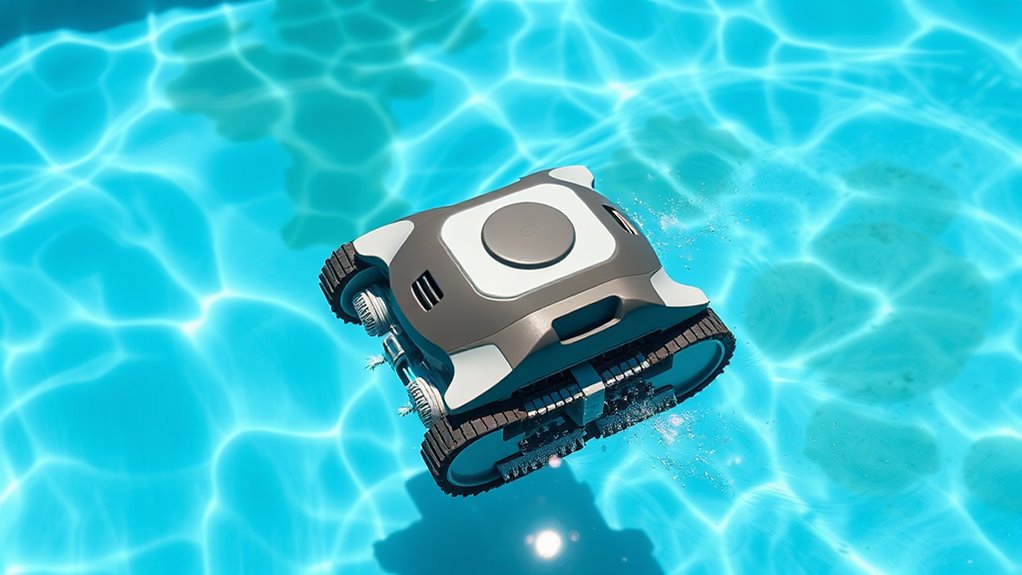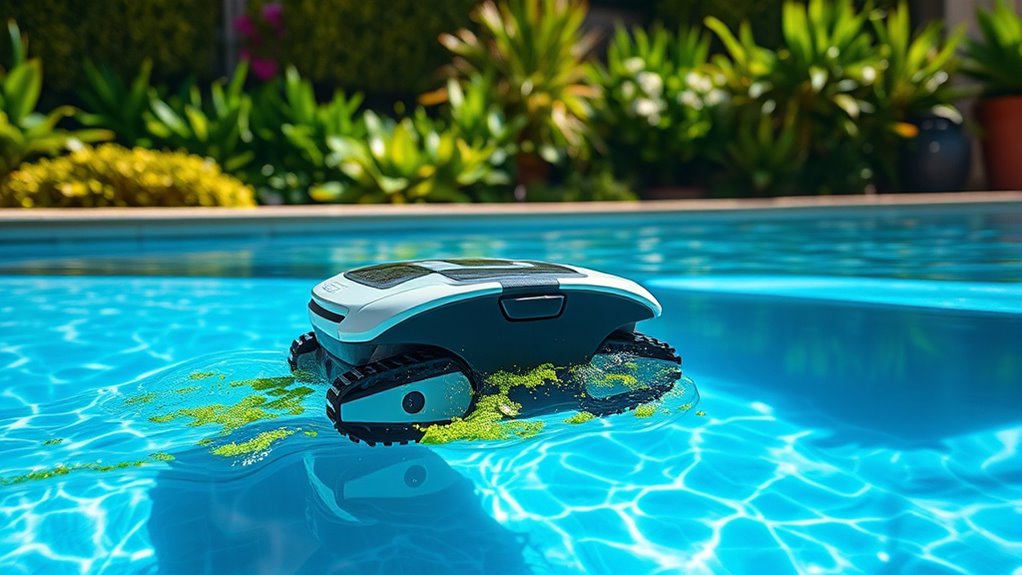Automatic pool cleaners help remove debris and improve water circulation, but they can’t fully eliminate algae or cloudy water on their own. You need to maintain proper chemical balance, shock the pool, and use algaecides to fight algae effectively. Regular filter cleaning and chemical adjustments are essential for clear water. Keep in mind, combining mechanical cleaning with chemical treatment gives the best results—stick around to learn more about making your pool sparkle.
Key Takeaways
- Automatic cleaners remove debris but do not eliminate algae or address chemical imbalances.
- They improve water circulation, aiding chemical distribution to prevent cloudiness.
- Effective algae and cloudiness control require chemical treatments like shock and algaecides.
- Regular filter cleaning enhances the cleaner’s efficiency and overall water clarity.
- Combining mechanical cleaning with proper chemical maintenance yields the best pool results.

Are you tired of spending hours scrubbing your pool manually? If so, you’ve probably wondered whether automatic pool cleaners can truly handle the tough issues like algae buildup and cloudy water. The truth is, these devices are designed to make your pool maintenance easier, but their effectiveness depends on understanding the chemistry challenges involved and applying the right maintenance tips. Algae and cloudiness often stem from imbalances in your pool’s chemical levels, such as pH, sanitizer, and alkalinity. Automatic cleaners can remove debris and dirt, but they don’t address the root cause of algae blooms or prevent future growth without your intervention. Applying algaecides and shock treatments as part of your maintenance tips is vital to kill existing algae and prevent its spread. Once the chemical challenge is managed, the cleaner can then effectively remove dead algae and debris, helping to restore a clean, clear pool. Additionally, maintaining proper circulation and ensuring consistent filtration can help prevent algae from returning. Proper circulation helps distribute chemicals evenly and reduces the chances of stagnant areas where algae can thrive. Regular circulation also aids in the efficient functioning of your filtration system, further improving water clarity. Cloudy water often results from inadequate filtration, bacteria, or improper chemical levels. Automatic pool cleaners excel at circulating water through the filtration system, helping to remove small particles and debris that contribute to cloudiness. However, if the water remains cloudy despite running your cleaner regularly, it’s a sign you might need to adjust your chemical levels or clean your filter more frequently. Regular maintenance tips include backwashing your filter, testing water chemistry weekly, and adjusting sanitizer levels accordingly. Additionally, using clarifiers can help bind small particles together, making them easier for the filter to capture. Staying consistent with filter maintenance is essential to maintaining clear water and preventing future cloudiness issues. Incorporating proper chemical balance as part of your routine will enhance the effectiveness of your automatic cleaner and overall water quality. While automatic pool cleaners aren’t a cure-all for algae and cloudy water, they are valuable tools when paired with proper chemical maintenance. They reduce the workload and improve circulation, but they won’t replace the need for regular chemical testing and adjustments. Understanding the chemistry challenges behind algae and cloudiness helps you use your cleaner more effectively. By staying consistent with maintenance tips like balancing chemicals, cleaning filters, and shocking your pool periodically, you’ll maximize the benefits of your automatic cleaner. Ultimately, combining mechanical cleaning with chemical care ensures your pool stays sparkling clean and inviting all season long. Regular chemical testing and maintenance are key to preventing future problems and keeping your pool in optimal condition.
Frequently Asked Questions
Can Automatic Cleaners Remove Algae From Pool Walls Effectively?
Automatic pool cleaners can be effective at removing algae from pool walls, thanks to their robotic efficiency. However, their ability to handle algae adhesion varies; some models may struggle with stubborn spots, especially if algae cling tightly. For best results, you should pre-treat your pool with algaecide and brush the walls. Then, let the cleaner do its job to maintain a clearer, cleaner pool.
How Often Should I Run My Automatic Cleaner in a Cloudy Pool?
You should run your automatic cleaner daily in a cloudy pool to maintain cleanliness and prevent algae buildup. Regular pool maintenance involves consistent cleaning to keep debris at bay, but chemical balancing is essential to clear the water. By sticking to a routine, you guarantee your pool stays inviting and safe. Automated cleaning helps, but don’t forget to test and adjust your chemicals regularly for peak clarity.
Are Automatic Pool Cleaners Suitable for Pools With Heavy Algae Growth?
A stitch in time saves nine, and that’s especially true for algae removal in your pool. Automatic pool cleaners are great for maintaining a cloudy pool, but heavy algae growth often needs more than just regular cleaning. They can help, but for severe algae, you’ll need to manually scrub and treat the water with algaecides and chlorine first. Relying solely on cleaners may not be enough for thorough algae removal.
Do Automatic Cleaners Require Pre-Treatment for Algae or Cloudiness?
Before using your automatic pool cleaner, you should perform pre-treatment procedures like brushing algae and vacuuming debris. Make certain your water has proper chemical balancing to prevent algae growth and cloudiness. Automatic cleaners are effective for maintenance after initial treatment, but they won’t replace chemical adjustments. By pre-treating and balancing chemicals, you help your cleaner work efficiently and keep your pool clear and healthy.
Can Automatic Cleaners Prevent Algae From Returning After Cleaning?
Automatic pool cleaners can help with algae prevention by keeping the pool’s surfaces clear and reducing debris buildup. However, they don’t replace regular chemical treatments needed for algae control. To prevent algae from returning, you must maintain proper chemical balance and perform routine cleaner maintenance. By combining consistent chemical management and regular cleaning, you guarantee your pool stays clear and algae-free for longer periods.
Conclusion
Automatic pool cleaners are effective at handling algae and cloudy water, especially when paired with proper chemical treatment. Did you know that over 80% of pool owners report cleaner, clearer pools within days of using an automatic cleaner? While they’re great for maintenance, don’t forget to brush and shock your pool regularly. With consistent care, your pool stays inviting and algae-free, making every swim invigorating and worry-free.










